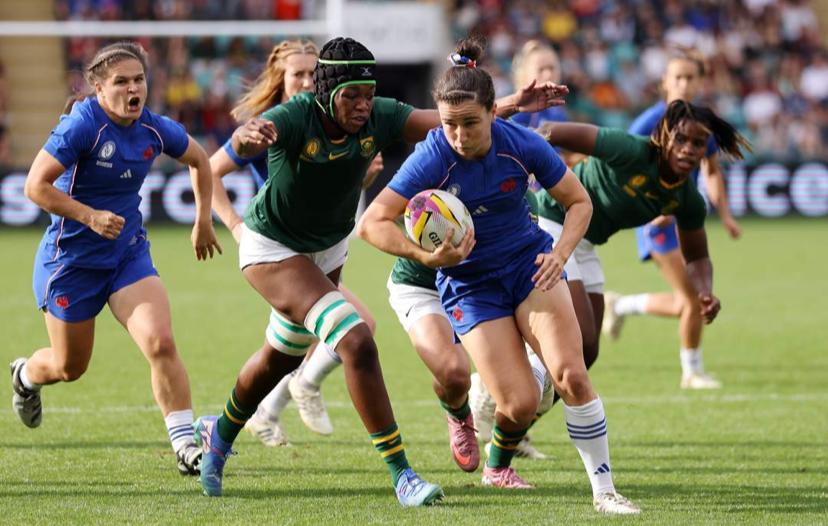
Springboks Women Faces Defeat to France. Image: Paul Harding/ Getty Images.
(The Post News)– France Hands Ruthless Reality Check to Brave but Outclassed Springboks Women. There’s something deeply unsettling about performing well and still getting thrashed.
It serves as a cold reminder that sport operates within a hierarchy, one that isn’t always negotiable. Some ceilings aren’t made of glass; they don’t shatter just because you want them to. South Africa learned that the hard way in Northampton, where a brilliant French side handed them a 57-10 defeat that felt more brutal than the scorelinesuggests.
Springboks vs. France.
At first glance, the score implies South Africa played poorly, fumbling through 80 minutes and earning a deserved hiding. But that doesn’t tell the full story. Not entirely. For much of the first half, before France’s late surge broke the game open and the Springboks’ resistance waned, South Africa held their own.
In those early stages, they showed flashes of growth. Aseza Hele once again imposed herself from the back of the pack. Nadine Roos injected pace and energy from scrum-half and even scored South Africa’s lone try in the dying moments, a well-crafted effort arguably the best of the match. Byrhandre Dolf, always noticeable with her scrum-cap and elusive running, threatened from broken play.
Against a weaker opponent, South Africa would have padded the stat sheet with meters gained, tackles broken, and defenders beaten. But this wasn’t a lesser side. France played with ruthless intent and reminded the Springboks that, despite their clear improvements, they still have significant ground to cover before joining rugby’s elite.
Head coach Swys de Bruin rotated heavily, making 10 changes to the side that beat Italy. With a quarter-final spot already secured, he had the freedom to experiment. And, truthfully, even his strongest lineup would likely have faced a similar result. The scoreboard may have looked different, but the outcome, a date with New Zealand in the last eight, remained inevitable.
One experiment did yield a definitive answer: Libbie Janse van Rensburg is this team’s most important player. Though better suited to center, her physicality and ability to carry over the gain line make her essential at fly-half in this system. Mary Zulu offered neat touches but lacked the power and kicking presence that Janse van Rensburg brings.
Defensively, South Africa also exposed a weakness. France, with their slick offloads and support play, found gaps with ease. They didn’t need set plays to score. Their continuity overwhelmed the Boks. Alexandra Chambon’s score from a dominant scrum was notable, but more worrying were the repeated line breaks from simple offloads and quick phases.
South Africa relied heavily on a singular approach: short carries, short passes, direct running, and fringe support. It worked in patches. Despite conceding early through Emilie Boulard, a Dolf penalty cut the lead to 5-3 and suggested a balanced contest. But as France adapted, shifting the point of contact and moving the ball wider, South Africa scrambled more and more. That’s a gamble that rarely pays off for long.
Once their Plan A fell apart, the Springboks had no alternative. Their inability to stretch the French defense or consistently breach the 13 channel stalled any meaningful momentum. Chumisa Qawe’s red card at 25 minutes, after a high tackle on Marine Menager, only deepened their struggles. With a player down, South Africa couldn’t maintain possession or pose a threat.
France punished every mistake. They scored four tries before halftime and added five more after the break. Most came from either scrum dominance or quick tap penalties that caught the Springboks off guard. The few exceptions, like a rapid line-out and a length-of-the-field try, only reinforced the fact that South Africa struggled to cope with France’s variety and tempo.
In the end, it was a jinking run from Roos in the final minute that salvaged some pride—a try that at least gave the Springboks something tangible to take home.
So, where does that leave them? De Bruin now knows which fringe players aren’t ready for this level, and that’s no disaster. Better to test depth in a low-stakes game than in a knockout round. He also saw positives: lateral interplay, a spark from the scrum-half, and Dolf’s counter-attacking threat. The scoreboard paints an ugly picture, but South Africa was not as poor as it suggests.
This team remains in transition, building chemistry, shaping an identity, and learning how to compete against the world’s best. France didn’t humiliate them; they educated them. The key takeaway? Rugby at the highest level demands more than bravery and physical effort. It requires adaptability, creativity, and precision.
South Africa left Northampton with bruises and clarity. They are not a finished product, but they’re no lost cause. They are evolving. The French exposed the gulf. Now the challenge is to close it quickly. Because the quarter-finals are here, and the world is watching.



